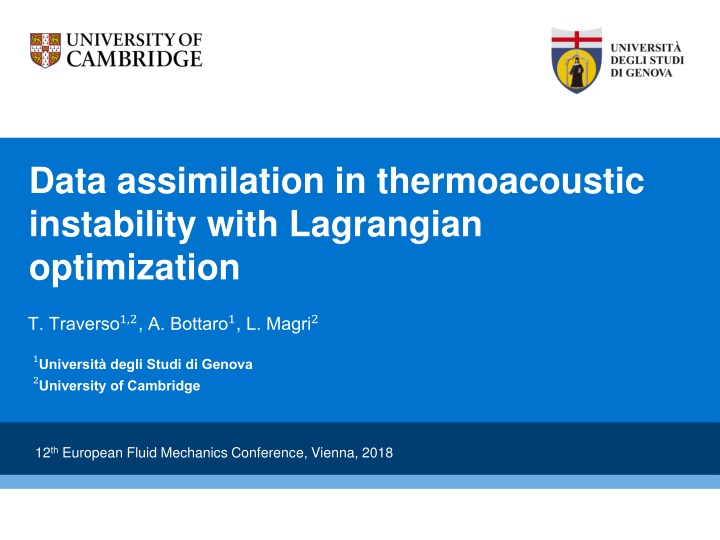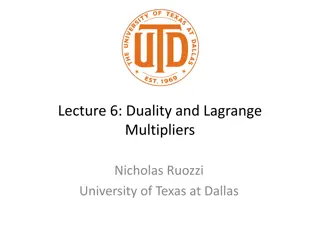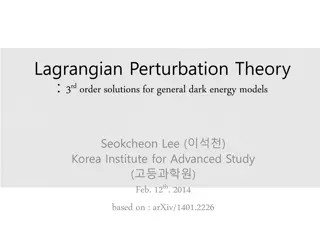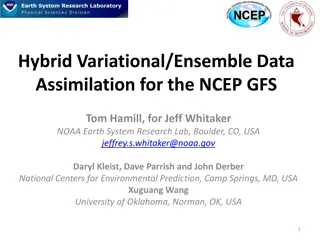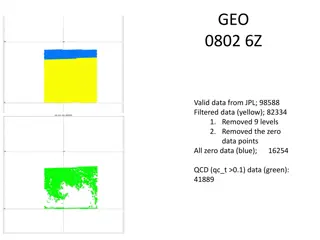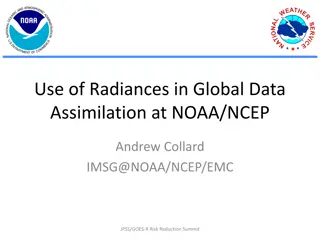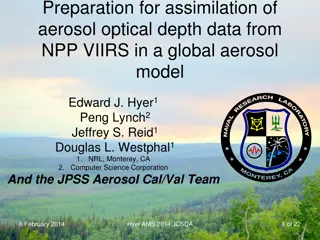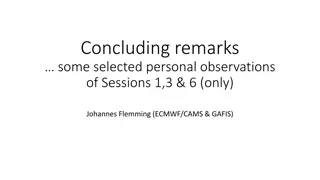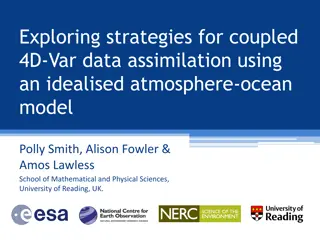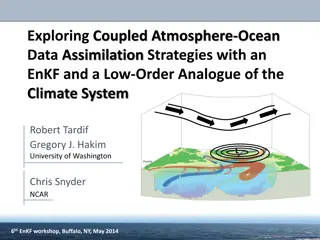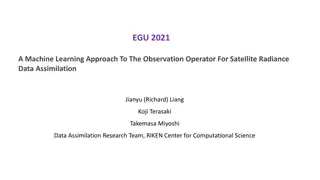Data Assimilation in Thermoacoustic Instability with Lagrangian Optimization
Thermoacoustic instabilities, a challenge for gas turbine manufacturers, are addressed through a low-order nonlinear thermoacoustic model. The model is discretized with natural acoustic modes, allowing for the quantitative accuracy of the qualitative model through data assimilation with Lagrangian optimization. The study focuses on capturing the time-delayed physics of thermoacoustic instabilities and calibrating flame parameters on the fly.
Download Presentation

Please find below an Image/Link to download the presentation.
The content on the website is provided AS IS for your information and personal use only. It may not be sold, licensed, or shared on other websites without obtaining consent from the author.If you encounter any issues during the download, it is possible that the publisher has removed the file from their server.
You are allowed to download the files provided on this website for personal or commercial use, subject to the condition that they are used lawfully. All files are the property of their respective owners.
The content on the website is provided AS IS for your information and personal use only. It may not be sold, licensed, or shared on other websites without obtaining consent from the author.
E N D
Presentation Transcript
Data assimilation in thermoacoustic instability with Lagrangian optimization T. Traverso1,2, A. Bottaro1, L. Magri2 1Universit degli Studi di Genova 2University of Cambridge 12th European Fluid Mechanics Conference, Vienna, 2018 T. Traverso, A. Bottaro, L. Magri
Structure of the talk 1. Thermoacoustics: Motivation and background 2. A low-order thermoacoustic model 3. How to make a qualitative model quantitatively accurate Data assimilation with Lagrangian optimization Transient dynamics vs dynamics at regime Data assimilation at regime Data assimilation during transient dynamics A more effective cost functional 4. Conclusions T. Traverso, A. Bottaro, L. Magri 2
Thermoacoustic oscillations are one of the biggest challenges faced by gas-turbine manufacturers Thermoacoustic oscillations are a multi-physical phenomenon, which is difficult to predict Uncontrolled oscillations can be detrimental, if not catastrophic Thermoacoustic instabilities Lieuwen & Yang, 2005 Poinsot, PROCI, 2017 T. Traverso, A. Bottaro, L. Magri 3
A low-order, nonlinear thermoacoustic model captures the time-delayed physics, which is the key physical mechanism of thermoacoustic instabilities Longitudinal acoustics Uniform mean flow Zero Mach number Ideal boundary conditions Momentum equation Energy equation T. Traverso, A. Bottaro, L. Magri 4
The thermoacoustic model is discretized with the natural acoustic modes Expansion in natural acoustic modes Discretized governing equations T. Traverso, A. Bottaro, L. Magri 5
How to make a qualitative model quantitatively accurate? T. Traverso, A. Bottaro, L. Magri 6
First, we augment the system to calibrate on the fly the flame parameters Parameters are regarded as constant variables 2?????????? ????? + ?? damping parameters (??) + 2 flame parameters (? and ?) degrees of freedom T. Traverso, A. Bottaro, L. Magri 7
Second, we optimize the statistical distance between the background and observations to obtain the optimal set of initial conditions and flame parameters T. Traverso, A. Bottaro, L. Magri 8
Second, we optimize the statistical distance between the background and observations to obtain the optimal set of initial conditions and flame parameters Background Statistical distance between analysis and background at t = 0 Observations Statistical distance between analysis and observations when observations are available B and R arecovariance matrices T. Traverso, A. Bottaro, L. Magri 9
The gradient is calculated by solving the adjoint equations of the state-augmented system Adjoint momentum Adjoint energy Adjoint heat release rate Adjoint damping factor Adjoint time delay e.g. Magri, Juniper, JFM, 2013 T. Traverso, A. Bottaro, L. Magri 10
The transient dynamics strongly depends on the number of modes. The higher the number, the more intricate the interaction. However, after the transient, the dynamics are dominated by the first modes 3 Modes P 10 Modes Time T. Traverso, A. Bottaro, L. Magri 11
Assimilation of thermoacoustic data: The twin experiments T. Traverso, A. Bottaro, L. Magri 12
During the transient, using more observations does not improve the analysis 10 Modes 50 Observations ? When many modes interact the true pressure signal can result from more different trajectories 250 Observations Time T. Traverso, A. Bottaro, L. Magri 13
At regime, using more observations improves the analysis 10 Modes 50 Observations ? 250 Observations Time T. Traverso, A. Bottaro, L. Magri 14
At regime, the analysis can be improved using a low assimilation frequency of observations because the dynamics are dominated by the first modes 10 Modes Sampling frequency = 4 ? Sampling frequency = 2 Time Highest frequency at regime is ? =?? ? For the Shannon theorem f=4 is necessary to improve the forecast Lower sampling frequency does not improve the analysis 2?= 2 T. Traverso, A. Bottaro, L. Magri 15
We can define cost functionals to constrain the pressure or pressure modes. The latter is more effective for data assimilation of thermoacoustics instabilities 10 Modes Measurements of the pressure ? Measurements of the pressure modes Time T. Traverso, A. Bottaro, L. Magri 16
Conclusions We proposed data assimilation with Lagrangian optimization to make a qualitative thermoacoustic model quantitatively accurate Assimilating the transient dynamics has a short-time benefit because of nonlinear mode interaction Assimilating the dynamics at regime has a long-time improvement because the physics is dominated by a handful of modes The minimum number of observations is constrained by the Shannon theorem We suggest a more effective cost functional based on the spectral content of the pressure Next: Assimilate experimental data T. Traverso, A. Bottaro, L. Magri 17
Back up slides T. Traverso, A. Bottaro, L. Magri 18
First, we augment the system to include the flame parameters in the assimilation. Second, we use external observations to train the model Definition of a cost functional, J Augmented system Improved state and parameters (analysis) Prediction (background solution) Optimization of statistical distance Low-order thermoacoustic model Guess on initial conditions and parameters (tau, beta) Observations (external data) T. Traverso, A. Bottaro, L. Magri 20
The Adjoint time series Adjoint pressure Oscillating variables reflect this behaviour in their adjoint (Lagrange multipliers) modes Time The sensitivity of J with respect to the heat release parameter ( ) increases with time Physical interpretation: J is sensitive to the total energy input +(adjoint ) Time T. Traverso, A. Bottaro, L. Magri 21
